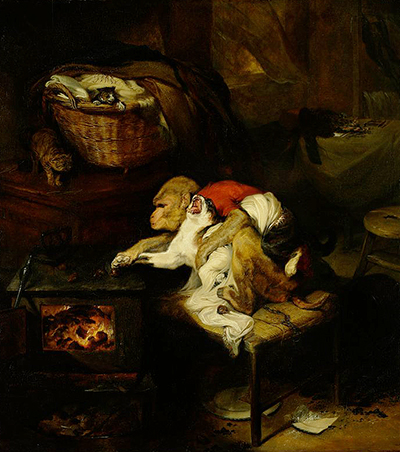The Cat's Paw is an oil on panel painting, done by Landseer in 1824. It uses the Romanticism style and falls under the genre of animal painting.
The Cat's Paw depicts a Jean de La Fontaines seventeenth-century fable showing a clever monkey persuading a cat to retrieve roasting chestnuts from the fire. By knocking roasting nuts from a hot stove, the cat is seen howling in pain. The symbolism of The Cat's Paw refers to a person unwittingly tricked by another in doing something for the other person. The colors used in The Cat's Paw are rich, earthy and warm. They blend harmoniously. The viewer's eyes are attracted immediately by the white cat that is seen howling in pain. The monkey in the red coat is also equally visible then the darker midsection that extends into the background.
The composition of The Cat's Paw depicts a portrait with figures located around the midsection where the main subjects are found. A little farther on the left top side of the paint are the cat's kitten that are also screaming, probably in an effort to scare the monkey and save their mother. The mood of The Cat's Paw is distressing, frightening, violent and thought-provoking. Looking at the picture evokes deep sympathetic emotions, given the dramatic events captured. Another key aspect of the paint is its use of lighting. Apparently from the paint, there is no directional source of light but due to the brightness especially around the midsection of the paint, it can be assumed that there was an artificial lighting source in the room. The redness of the burning stove clearly shows the intensity of the fire, that translates to the pain the cat must have felt from the burns.
Edwin Henry Landseer was impacted into the artistic world by several artists including his father John Landseer, a history painter Benjamin R. Haydon who is credited for encouraging Landseer to perform dissections in order to fully comprehend animal musculature and its skeletal structure. Landseer was also influenced by the Scotlands highlands, which inspired his later paintings such as The Monarch of the Glen. Other notable works by Landseer include Portrait of an Arab Mare with her Foal, Alpine Mastiffs Reanimating a Distressed Traveller and The Monarch of Glen.




